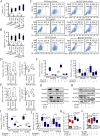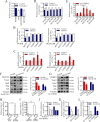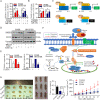M6A associated TSUC7 inhibition contributed to Erlotinib resistance in lung adenocarcinoma through a notch signaling activation dependent way
- PMID: 34656164
- PMCID: PMC8520306
- DOI: 10.1186/s13046-021-02137-9
M6A associated TSUC7 inhibition contributed to Erlotinib resistance in lung adenocarcinoma through a notch signaling activation dependent way
Erratum in
-
Correction: M6A associated TSUC7 inhibition contributed to Erlotinib resistance in lung adenocarcinoma through a notch signaling activation dependent way.J Exp Clin Cancer Res. 2023 Jul 24;42(1):179. doi: 10.1186/s13046-023-02760-8. J Exp Clin Cancer Res. 2023. PMID: 37488615 Free PMC article. No abstract available.
Abstract
Background: The small tyrosine kinase inhibitors (TKIs) subversively altered the lung cancer treatments, but patients will inevitably face the therapy resistance and disease recurrence. We aim to explore the potential roles of non-coding RNAs in sensitizing the TKIs effects.
Methods: Multiple cellular and molecular detections were applied to confirm the mechanistic regulations and intracellular connections.
Results: We explored the specific gene features of candidates in association with resistance, and found that m6A controlled the stemness of EMT features through METTL3 and YTHDF2. The miR-146a/Notch signaling was sustained highly activated in a m6A dependent manner, and the m6A regulator of YTHDF2 suppressed TUSC7, both of which contributed to the resistant features. Functionally, the sponge type of TUSC7 regulation of miR-146a inhibited Notch signaling functions, and affected the cancer progression and stem cells' renewal in Erlotinib resistant PC9 cells (PC9ER) and Erlotinib resistant HCC827 cells (HCC827ER) cells. The Notch signaling functions manipulated the cMYC and DICER inner cytoplasm, and the absence of either cMYC or DICER1 lead to TUSC7 and miR-146a decreasing respectively, formed the closed circle to maintain the balance.
Conclusion: PC9ER and HCC827ER cells harbored much more stem-like cells, and the resistance could be reversed by Notch signaling inactivation. The intrinsic miR-146 and TUSC7 levels are monitored by m6A effectors, the alternation of either miR-146 or TUSC7 expression could lead to the circling loop to sustain the new homeostasis. Further in clinics, the combined delivery of TKIs and Notch specific inhibitory non-coding RNAs will pave the way for yielding the susceptibility to targeted therapy in lung cancer.
Keywords: Cancer stem cells; N6-methyladenosine; Notch signaling; Therapy resistance; Tyrosine kinase inhibitors.
© 2021. The Author(s).
Conflict of interest statement
The authors declare that they have no competing interests” in this section.
Figures





References
-
- Chen WQ, Zuo TT, Zheng RS, Zeng HM, Zhang SW, He J. Lung cancer incidence and mortality in China in 2013. Zhonghua Zhong Liu Za Zhi. 2017;39(10):795–800. - PubMed
-
- Raaschou-Nielsen O, Andersen ZJ, Beelen R, Samoli E, Stafoggia M, Weinmayr G, et al. Air pollution and lung cancer incidence in 17 European cohorts: prospective analyses from the European study of cohorts for air pollution effects (ESCAPE) Lancet Oncol. 2013;14(9):813–822. doi: 10.1016/S1470-2045(13)70279-1. - DOI - PubMed
MeSH terms
Substances
Grants and funding
LinkOut - more resources
Full Text Sources
Medical

